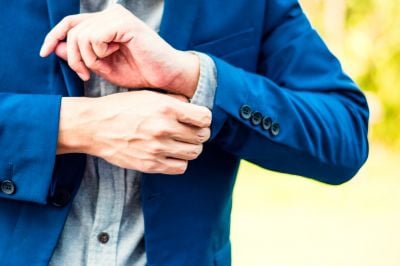We’ve discussed finding the right tuxedo for you, and we know that not every occasion is a black-tie affair. Sometimes you just need a classy-looking suit and tie for a wedding, office party, or your day-to-day work attire. If you’ve looked into purchasing a suit at all, you’ve found out that your options are seemingly endless. You may be wondering how to best choose a color or pattern. The following tips are to help you go into the store with a better idea of what to look for in a suit:
What to Pair with Your Suit
Before we get into the meat of selecting the right suit for you, we’d like to first talk about what to wear with the suit. Depending on the day’s events, you may not have to wear a button-down shirt and tie. Many men are wearing T-shirts, sweaters, and even tennis shoes with their suits. The choice is ultimately yours to make about what’s appropriate for your situation.
Find the Store with the Biggest Selection
If you’re unsure of what suit to buy, first go into a department store like Nordstrom or a specialty store like Men’s Wearhouse. Browse the racks for something that catches your eye and when you’re ready, find a salesperson. The salesperson will be able to help you choose the right cut and fit as they have a wide variety of pants and jackets for you to try.
A Jacket That’s Built for Style and Comfort
With so many styles of jackets to choose from, it may seem overwhelming. Relax. Different cuts and styles look best on different builds. For instance, a shorter, wider man will not receive the same flattering benefits of a double-breasted jacket. A single-breasted, two-button jacket is much better for a short man.
The jacket’s fit is extremely important. It should cover your bottom while lying flat on your back. Similarly, it shouldn’t pull or pucker anywhere on your torso. The sleeves should be cut to stop at your wrist and the sleeves of your shirt should peek out about a quarter to half an inch.
You absolutely must be able to have a full range of motion in your jacket. Your arms should be able to move freely and the jacket should fit your shoulders and not restrict them in any way.
Pants to Complement the Look
The pants you wear are also extremely important and shouldn’t be forgotten. It would be pointless to wear a jacket that makes you look like a million bucks but a pair of trousers that makes you look like spare change.
Like the jacket, the fit of the pants is paramount to selecting the right pair for you. Note that suit pants sit around your natural waist, not lower like casual trousers.
Suit pants should have cuffs. The only exception to that rule is for short men who want to appear taller.
The break -- the crease created where the top of your shoe meets your pants -- should also be considered. Unless you’re tall, go with a slight or medium break. Tall men should choose a full break because a slight or medium break makes their pants look like they’re too short.
Pattern and Color Selection
Know why you’re buying the suit. If you’re buying a suit to wear more than once a week at work, you’ll want to go with a dark color. (Note: navy is a perfect option for your first suit due to its versatility.)
As you build your collection, you can add black, gray or even earth tones to your collection. You can also play with patterns like pinstripes or window panes.
Finding the right suit may seem daunting, but we assure your investment will pay off. A great suit can last a long time. The suit you buy will make you look good and ready to take on any occasion life sends your way.



(0) comments
We welcome your comments
Log In
Post a comment as Guest
Keep it Clean. Please avoid obscene, vulgar, lewd, racist or sexually-oriented language.
PLEASE TURN OFF YOUR CAPS LOCK.
Don't Threaten. Threats of harming another person will not be tolerated.
Be Truthful. Don't knowingly lie about anyone or anything.
Be Nice. No racism, sexism or any sort of -ism that is degrading to another person.
Be Proactive. Use the 'Report' link on each comment to let us know of abusive posts.
Share with Us. We'd love to hear eyewitness accounts, the history behind an article.